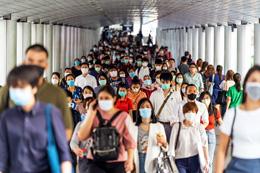New COVID-19 Wave Sweeps Through Asia

By Mata Press Service
From Singapore to Hong Kong, and across China and Thailand, a renewed wave of COVID-19 is sweeping through some of Asia’s most populous and globally connected regions. At the heart of this resurgence is the highly transmissible and immune-resistant JN.1 variant and its descendants, LF.7 and NB.1.8, which now dominate sequenced infections in the region.
While the world has largely moved on from the pandemic’s darkest days, the virus is again making headlines, not just for its resurgence, but for the warning it sends: COVID-19 is far from over.
In Singapore, COVID-19 cases surged by 28% in the week ending May 3, climbing to 14,200 — the highest weekly tally in nearly a year. Hospitalizations rose by nearly 30%, prompting the government to release its first detailed figures on the outbreak since last year — a move typically reserved for situations of serious public health concern.
Health authorities in the city-state say the majority of new infections are linked to LF.7 and NB.1.8, two sub-lineages of the JN.1 variant, which together account for more than two-thirds of all sequenced cases. Although these strains haven’t shown increased severity, their ability to bypass previous immunity is troubling.
“The current rise in cases is largely due to waning population immunity,” said Singapore’s Ministry of Health. The government is now urgently urging high-risk groups — including seniors and those with underlying conditions — to receive booster shots immediately.
Hong Kong is experiencing a parallel spike. The city's Centre for Health Protection has reported a significant increase in respiratory sample positivity rates, which have more than doubled in the past month — reaching a one-year high of 13.66%.
Wastewater surveillance data is also raising red flags, with virus concentration levels rising sharply across the city. In the week ending May 3, Hong Kong recorded 81 severe COVID-19 cases — a 12-month peak — with 30 deaths, mostly among elderly patients or individuals with pre-existing conditions.
Even the entertainment industry has felt the impact: celebrated singer Eason Chan was forced to cancel his Taiwan concert after contracting the virus, further underscoring the reach of the current wave.
In mainland China, hospitals have reported a doubling of test positivity rates over the past five weeks. The China Center for Disease Control and Prevention (CDC) noted that the positivity rate jumped from 7.5% in early April to 16.2% by May 10, suggesting the nation may be on the brink of another major wave, similar to the summer surge of 2023.
Although official nationwide case numbers are limited, experts say the jump in hospital-based testing and the rate of severe outcomes are clear signs of community spread on the rise.
Thailand’s COVID-19 rebound has been linked to large public gatherings during April’s Songkran Festival. According to the Department of Disease Control, two significant outbreaks have occurred in recent months, leading health officials to ramp up calls for booster shots — particularly among vulnerable populations.
First identified in Luxembourg in late 2023, the JN.1 variant is now the dominant COVID-19 strain globally. With over 30 immune-evasive mutations, it has shown the ability to infect previously vaccinated or previously infected individuals. According to Johns Hopkins University, additional mutations have made it even more efficient at spreading than its BA.2.86 predecessor.
While the symptoms of JN.1 are generally consistent with previous COVID strains — including sore throat, fever, fatigue, and loss of taste or smell — some patients are also reporting gastrointestinal symptoms and conjunctivitis. Severity remains low in most vaccinated individuals, but concern is rising over its ability to outmaneuver existing immunity.
Governments across the region are ramping up public health campaigns, reintroducing data transparency measures, and urging at-risk individuals to get boosted immediately to prevent another wave of hospital overwhelm.
While India currently reports low case numbers — just 257 active cases as of May 19 — experts warn that the outbreaks in neighbouring countries may be a harbinger of things to come.
“This summer spike is unusual,” said Dr. Sandeep Budhiraja of Max Healthcare in India. “We typically don’t see respiratory viruses peak during warmer months. This tells us the virus is changing — and that should concern all of us.”
Dr. Rajeev Jayadevan, a leading infectious disease expert, echoed those sentiments, stating, “JN.1 is a fast-spreading, immune-evasive variant that could easily cause a wave in countries where vaccine-induced or natural immunity has waned.” – with agencies.









